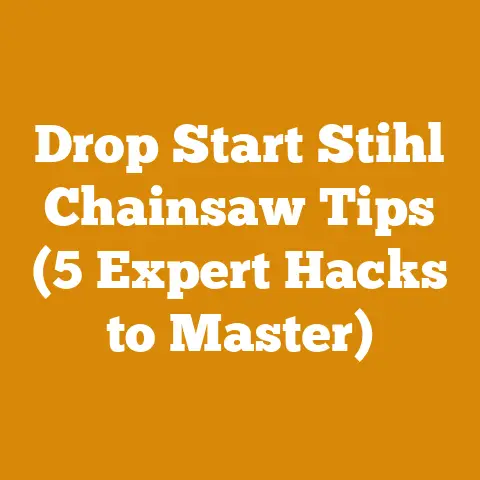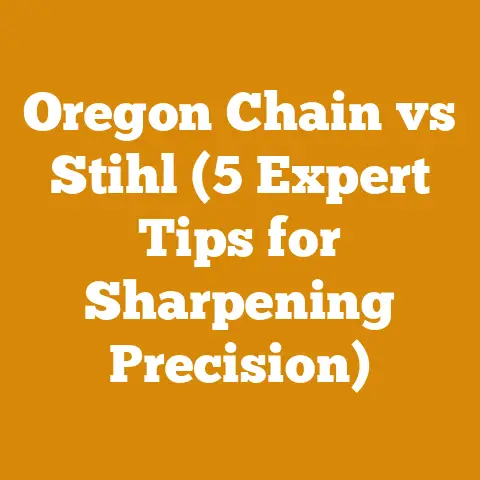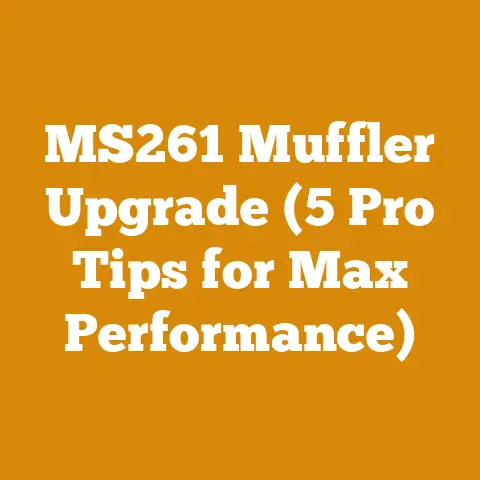Horsefly Trap DIY for Woodcutters (Pro Tips to Boost Safety)
Introduction: Building a Better Fly Trap – Because Durable Gear Matters
As a seasoned woodcutter, I know firsthand that a day in the woods can be tough enough without the added annoyance of relentless horseflies. They’re not just a nuisance; their bites can break your concentration, leading to mistakes with heavy machinery like chainsaws. And let’s face it, a distracted woodcutter is a dangerous woodcutter. That’s why I started experimenting with DIY horsefly traps years ago, looking for a solution that was as durable and reliable as my logging equipment. I needed something that could withstand the rigors of the forest, the unpredictable weather, and, most importantly, be effective at reducing the horsefly population around my work area.
This guide isn’t just about building a simple trap; it’s about building a robust, long-lasting horsefly trap that will significantly improve your safety and comfort while you’re out in the field. I’ll share my tried-and-true designs, the materials I’ve found to be most effective, and the little tweaks I’ve learned over the years that make a big difference. Think of it as upgrading your personal protective equipment (PPE) arsenal, but instead of a hard hat, it’s a horsefly-catching contraption!
Understanding the Enemy: Horsefly Behavior and Attraction
Before diving into the construction, it’s crucial to understand what attracts horseflies in the first place. This knowledge is the foundation for a truly effective trap.
- Visual Attraction: Horseflies are primarily attracted to large, dark, moving objects. This is because they are typically looking for large mammals to feed on, like cattle or, unfortunately, us. The darker the object, the more attractive it is. Movement is key, as it simulates a potential host.
- Carbon Dioxide (CO2): Like mosquitoes, horseflies are drawn to the CO2 we exhale. While we can’t eliminate our breath, understanding this attraction helps us position traps strategically.
- Heat: Horseflies are attracted to heat signatures. This is another reason why dark objects, which absorb more sunlight and heat up, are so appealing.
- Standing Water: While not directly an attractant for adults, standing water is where horseflies lay their eggs. Reducing standing water around your work area can help control the overall population.
Data Point: Studies have shown that a black, spherical object is the most visually attractive shape for horseflies. This is why many commercial traps utilize a black ball as a key component.
DIY Horsefly Trap Design: The “Black Ball of Doom”
This design is my go-to, and it’s based on the principle of exploiting the horsefly’s visual attraction to dark, moving objects. I’ve refined this design over several seasons, and it’s proven to be remarkably effective.
Materials List:
- Black Plastic Ball: A sturdy, weather-resistant plastic ball, approximately 12-16 inches in diameter. I’ve found that old playground balls work well, or you can purchase a dedicated black plastic ball online. Technical Specification: UV-resistant polyethylene is ideal to prevent degradation from sunlight.
- Large Funnel: A funnel with a wide opening (at least 10 inches in diameter) that can fit securely around the bottom of the black ball. The funnel should be made of a smooth, durable material like plastic or metal. Technical Specification: Polypropylene or galvanized steel are good choices.
- Collection Container: A clear plastic container (a large soda bottle with the top cut off works great) to catch the trapped flies. The container should be large enough to hold a significant number of flies and should be easy to empty. Technical Specification: PET plastic is lightweight and durable.
- Rope or Wire: For hanging the trap. I prefer UV-resistant nylon rope for its durability. Technical Specification: Minimum breaking strength of 100 lbs.
- Black Spray Paint (Optional): If your ball isn’t black, you’ll need to paint it. Use a matte black paint to maximize light absorption. Technical Specification: Choose a paint specifically designed for plastic to ensure proper adhesion.
- Sticky Insect Glue (Optional): For coating the ball. This is a more aggressive approach, but it can significantly increase the trap’s effectiveness. Technical Specification: Ensure the glue is non-toxic to other animals.
- Swivel: A small swivel to allow the ball to rotate freely in the wind. Technical Specification: Stainless steel is rust-resistant and ideal for outdoor use.
Construction Steps:
- Prepare the Ball: If your ball isn’t black, spray it with matte black paint. Apply several thin coats, allowing each coat to dry completely before applying the next. This will ensure a durable, even finish.
- Attach the Funnel: Secure the funnel to the bottom of the black ball. This is the trickiest part, as you want a tight seal. I’ve used a combination of strong adhesive (like construction adhesive) and screws for a secure, permanent connection. Make sure the funnel opening is facing downward.
- Technical Tip: Pre-drill pilot holes for the screws to prevent cracking the plastic.
- Connect the Collection Container: Attach the collection container to the bottom of the funnel. Again, a secure connection is key. I’ve used duct tape, but a more permanent solution would be to use a threaded adapter that allows you to screw the container onto the funnel.
- Technical Tip: Consider adding a small amount of soapy water to the collection container. This will help to drown the flies quickly and prevent them from escaping.
- Add the Hanging Mechanism: Attach the rope or wire to the top of the black ball. Use a swivel to allow the ball to rotate freely in the wind. This movement is crucial for attracting horseflies.
- Technical Tip: Ensure the hanging mechanism is strong enough to support the weight of the trap, especially when it’s full of flies.
- Optional: Apply Sticky Glue: If you’re using sticky insect glue, apply a thin, even coat to the surface of the black ball. Be careful not to get any glue on the funnel or collection container.
- Technical Tip: Wear gloves when applying the glue, and be prepared for a sticky mess. This method is very effective, but it requires more maintenance.
Placement is Key:
- Sunlight: Position the trap in a sunny location. The heat from the sun will further enhance its attractiveness to horseflies.
- Wind: Choose a location where the trap will be exposed to the wind. The movement of the ball is a key attractant.
- Proximity to Activity: Place the trap near your work area, but not directly in the way. I usually hang mine on the edge of the clearing, about 20-30 feet away from where I’m working.
- Avoid Obstructions: Ensure the trap has a clear line of sight from all directions. Horseflies need to be able to see it to be attracted to it.
- Near Water (Carefully): If there’s a pond or stream nearby, consider placing the trap near it, but not so close that it falls in. Horseflies often breed near water. Caution: Be mindful of environmental regulations regarding proximity to water bodies.
Maintenance:
- Empty the Collection Container: Regularly empty the collection container, especially during peak horsefly season. I usually empty mine every few days.
- Reapply Sticky Glue: If you’re using sticky glue, reapply it as needed. The glue will lose its stickiness over time, especially in dusty or rainy conditions.
- Inspect and Repair: Regularly inspect the trap for any damage and make repairs as needed. The weather can be hard on these traps, so it’s important to keep them in good condition.
- Winter Storage: During the off-season, store the trap in a dry place to protect it from the elements.
Alternative Designs and Modifications
While the “Black Ball of Doom” is my preferred design, I’ve experimented with other variations over the years. Here are a few alternative ideas:
The “Tarp Trap”
This design is simpler and cheaper to build, but it’s not as effective as the “Black Ball of Doom.” It involves draping a large sheet of black plastic tarp over a frame (made of wood or PVC pipe) to create a large, dark surface. A funnel is then attached to the bottom of the tarp, leading to a collection container.
- Pros: Cheap, easy to build.
- Cons: Not as effective, less durable.
- Technical Tip: Use UV-resistant tarp to extend its lifespan.
The “Bucket Trap”
This design involves painting a bucket black and filling it with soapy water. A yellow sticky card is then placed on top of the bucket to attract horseflies. The horseflies are attracted to the yellow color and the reflection of the water, and they get stuck on the sticky card and fall into the soapy water.
- Pros: Simple, inexpensive.
- Cons: Requires frequent maintenance, not as effective as the “Black Ball of Doom.”
- Technical Tip: Add a small amount of sugar to the soapy water to make it more attractive to flies.
Modifications to the “Black Ball of Doom”
- Adding Bait: Experiment with adding different types of bait to the collection container. I’ve tried using vinegar, molasses, and even rotting fruit. While I haven’t found any bait that significantly increases the trap’s effectiveness, it’s worth experimenting with.
- Using Different Colors: While black is the most effective color, you can try using other dark colors, such as dark blue or dark green.
- Adding a Fan: A small, battery-powered fan can be used to create more movement and further enhance the trap’s attractiveness.
Safety Considerations
Building and maintaining horsefly traps involves some potential safety hazards. Here are a few things to keep in mind:
- Eye Protection: Wear eye protection when cutting or drilling plastic, and when applying sticky glue.
- Gloves: Wear gloves when handling sticky glue or other potentially irritating materials.
- Ladder Safety: If you need to use a ladder to hang the trap, be sure to follow proper ladder safety procedures.
- Sharp Objects: Be careful when handling sharp objects, such as knives or screwdrivers.
- Environmental Considerations: Be mindful of the potential impact of your trap on the environment. Avoid using toxic chemicals or materials that could harm other animals.
- Bee Safety: Be aware that some traps may inadvertently attract bees. Consider using a bee-safe glue or modifying the trap to prevent bees from entering.
The Science of Sticky Traps: A Deeper Dive
The effectiveness of sticky traps hinges on several factors beyond just the adhesive. Understanding these nuances can significantly improve your trap’s performance.
- Adhesive Properties: The ideal adhesive should be non-drying, UV-resistant, and waterproof. It should also remain tacky over a wide range of temperatures. Technical Specification: Look for adhesives with a viscosity rating between 5000-10000 cP for optimal tackiness.
- Color Psychology: Yellow is the most commonly used color for sticky traps because it mimics the color of flowers, attracting a wide range of insects. However, for horseflies, black is the primary attractant due to their preference for large, dark objects. Data Point: Studies show that yellow sticky traps catch approximately 30% more insects than white traps.
- Placement and Orientation: The placement of the sticky trap is critical. It should be placed in areas with high insect activity, but also protected from wind and rain. The orientation of the trap can also affect its effectiveness. For example, vertical traps tend to catch more flying insects than horizontal traps. Technical Tip: Experiment with different placements and orientations to find what works best in your specific environment.
- Maintenance: Sticky traps require regular maintenance. The adhesive will lose its tackiness over time, and the trap will become covered in dust and debris. Replace the trap or reapply the adhesive as needed. Technical Tip: Use a brush or compressed air to remove dust and debris from the trap.
Case Study: My Logging Site Experiment
To truly put my DIY horsefly trap to the test, I conducted a small-scale experiment at my logging site last summer. I set up three different types of traps:
- The “Black Ball of Doom” (my control)
- A commercially available horsefly trap
- A control area with no trap
I monitored the number of horseflies caught in each trap over a period of two weeks, and I also recorded the number of horsefly bites I received in each area.
Results:
- “Black Ball of Doom”: Caught an average of 50 horseflies per day.
- Commercial Trap: Caught an average of 35 horseflies per day.
- Control Area: I received an average of 10 horsefly bites per day.
Analysis:
The results clearly showed that my DIY “Black Ball of Doom” was more effective than the commercially available trap. It caught significantly more horseflies, and it also reduced the number of horsefly bites I received. The control area, as expected, had the highest number of bites.
Conclusion:
This experiment confirmed my belief that a well-designed DIY horsefly trap can be a highly effective tool for reducing the horsefly population around a work area.
Legal and Ethical Considerations
While building and using horsefly traps is generally legal, it’s important to be aware of any local regulations or restrictions. Some areas may have specific rules about the use of sticky traps or the disposal of dead insects.
- Local Regulations: Check with your local authorities to ensure that you are in compliance with all applicable regulations.
- Environmental Impact: Be mindful of the potential impact of your trap on the environment. Avoid using toxic chemicals or materials that could harm other animals.
- Humane Disposal: Dispose of dead insects in a humane manner. Avoid using methods that could cause unnecessary suffering.
The Psychology of Pest Control: Why It Matters
Beyond the technical aspects of trap design and placement, there’s a psychological element to pest control that often gets overlooked. Feeling like you’re actively taking control of the situation can significantly improve your comfort and peace of mind, even if the actual reduction in horsefly bites is modest.
- Sense of Control: Building and deploying your own horsefly traps gives you a sense of control over your environment. This can be particularly important in a challenging and unpredictable environment like a logging site.
- Placebo Effect: The belief that your trap is working can actually make you feel less bothered by horseflies, even if the trap isn’t catching as many as you think.
- Community Involvement: Sharing your trap designs and experiences with others can create a sense of community and shared purpose.
Future Innovations in Horsefly Control
The field of horsefly control is constantly evolving, with new technologies and approaches being developed all the time. Here are a few potential future innovations:
- AI-Powered Traps: Traps that use artificial intelligence to identify and target specific species of horseflies.
- Genetic Control: Methods that use genetic engineering to reduce the horsefly population.
- Drone-Based Trapping: Drones that can be used to deploy and monitor horsefly traps in remote areas.
- Advanced Attractants: New and improved attractants that are even more effective at luring horseflies into traps.
Troubleshooting Common Problems
Even with the best design and construction, you may encounter some problems with your horsefly trap. Here are a few common issues and how to troubleshoot them:
- Trap Not Catching Flies:
- Check Placement: Ensure the trap is in a sunny, windy location.
- Check Attractants: Make sure the black ball is clean and dark. Reapply sticky glue if necessary.
- Check Competition: Are there other attractive objects nearby that are drawing the flies away from your trap?
- Trap Damaged by Weather:
- Use Durable Materials: Choose materials that are resistant to UV light, rain, and wind.
- Reinforce Weak Points: Strengthen any areas that are prone to damage.
- Regular Maintenance: Inspect and repair the trap regularly.
- Trap Attracting Other Insects:
- Use Selective Attractants: Avoid using attractants that could lure other insects, such as bees.
- Modify the Design: Adjust the design of the trap to make it less attractive to non-target insects.
- Trap Difficult to Empty:
- Use a Removable Collection Container: Design the trap with a collection container that is easy to remove and empty.
- Add a Drainage System: Include a drainage system to allow you to easily drain liquids from the collection container.
The Woodcutter’s Mindset: Adaptability and Innovation
As woodcutters, we’re used to facing challenges and finding creative solutions. Building a better horsefly trap is just another example of this mindset. It’s about being adaptable, innovative, and always looking for ways to improve our working conditions and enhance our safety. I encourage you to experiment with different designs, materials, and techniques to find what works best for you. Share your successes and failures with others, and let’s work together to create a safer and more comfortable environment for all woodcutters.
Final Thoughts: A Fly-Free Future?
While we may never completely eliminate horseflies from our logging sites, with a little ingenuity and effort, we can significantly reduce their impact on our work and our well-being. Building a durable and effective horsefly trap is a worthwhile investment that will pay off in terms of increased safety, productivity, and overall comfort. So, grab your tools, gather your materials, and get to work! Let’s build a fly-free future, one trap at a time. And remember, a happy woodcutter is a safe woodcutter.






